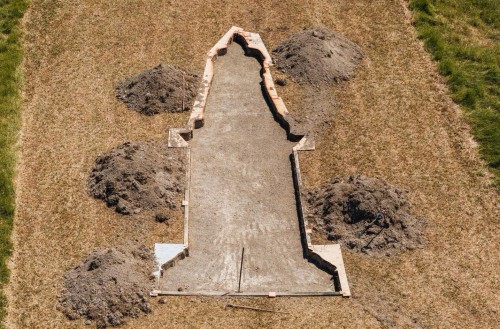
Anything could happen at Sculpture on the Gulf 2024
By Thomas Bywater
February 23, 2024
Sculpture on the Gulf 2024 is inviting visitors back to the Matiatia Coastal Walkway from today for a month-long celebration of art in an inspirational setting. With this year’s edition titled ‘Anything Can Happen’, you can expect a few surprises around the headland.
A prison tower has appeared on the Hauraki Gulf’s skyline. The ominous structure would look more at home on Alcatraz than Waiheke Island, but Wakefield Dreaming is a six-metre-high sculpture by Brett Graham, one of this year’s festival curators.
It is one of more than 20 world-class art installations that have landed on Waiheke island this weekend, in time for the biennial Sculpture on the Gulf.
Based on the sentinels around Paremoremo Prison, Graham’s work welcomes visitors and prepares them for a series of transformative experiences on the landscape, inviting them to explore more.
With affiliation to Ngāti Koroki Kahukura and Tainui, Graham’s art and “counter-monuments” have a track record for challenging how people see a place and its colonial history.
Having been on the Sculpture on the Gulf selection panel since 2007 and last exhibiting work in 2017, Graham says it has been two years of planning.
“It’s been a great process to be on the other side of the coin. Quite different to making work.”
Faced with the logistics of delivering enormous artworks and maintaining some mystery, Graham says it’s good to be able to see the artwork finally in context. Many of the artists are normally gallery- and exhibition-based, so took some coaxing to produce work for the outdoor Gulf setting. He says the final parts of some sculptures were still being put into place just days before Perpetual Guardian Sculpture on the Gulf 2024 opens to the public.
Working with co-curator Robert Leonard, director of Brisbane’s Institute of Modern Art, Graham says they were invited to “mix up” the selection process.
The 20th anniversary of the sculpture biennial will be a big event, although there are fewer sculptors involved this year.
With 21 artists compared to about 40 in previous years selected by a panel process, this year they’ve been able to devote more focus on each artwork.
“We’ve engaged artists directly and allocated them what they need to do whatever they want to,” he says.
There are structures to explore inside, like Ana Iti’s Whakaruruhau (“shelter”), which is based on the nest of the kahukura butterfly. There are also artworks that have been brought in from other parts of the country, such as Isabella Loudon’s No Tomorrow, caked in mud from the storm-battered Gulf of Hauraki - which Graham says “looks like detritus or something decaying” but is in response to the Auckland floods, Cyclone Gabrielle and the high waters that hit Hawke’s Bay last year.
Although the loop could be walked in under an hour, with help from a bus transfer to the headlands, there are sights and experiences that will make you linger longer and invite you to find shade.
Perhaps the artwork that is most at home in the island’s rolling landscape is Ralph Hotere’s Taranaki Gate Stations, which involves various eccentric Kiwi materials. This includes No. 8 wire and 14 live sheep.
Described as “one of the strangest pieces of religious art” to come out of New Zealand, the posthumous work by the Kiwi artist will change in the run-up to Easter, following the stations of the cross.
Visitors can also expect installations from Dennis O’Connor and Chris Booth.
It’s not only New Zealand’s finest being represented on Waiheke. This year’s sculpture trail features several international art stars, including Canadian indigenous artist Nicholas Galanin. Inspired by his Lingit and Unangax̂ heritage and the legacy of colonial monuments, his contribution is part burial, part crime scene and titled An Unmarked Grave Deep Enough to Bury Colony and Empire.
At the end of the 40-minute ferry from downtown Auckland, you expect to find an island transformed during the month-long festival, which concludes on March 24.
There will also be a series of artist talks, workshops and guided walks held throughout.
“Waiheke has a lot of pull. It’s an easy day trip from Auckland to walk the trail,” says Graham.